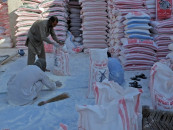Potohar needs more micro dams, experts
Construction of mini-dams and ponds has helped raise the underground water levels

PHOTO: EXPRESS
Apart from storing water for agriculture, the mini-dams can also help mitigate floods, conserve soil and eventually help arrest rural-urban migration ratios.
A team of experts have pointed out that due to rainfall patterns in the region, there is a need to harvest and store water to irrigate crops during the months of April to June and October to December.
The runoff available in the Potohar plateau is 3.5 million acre feet (MAF), of which 0.1 MAF is utilised by small dams, mini-dams and ponds.
‘Govt has allocated Rs100b for Diamer-Basha, Dasu dams’
The remaining 3.4 MAF flows down the Indus and Jhelum rivers.
Talking to APP, Soil Conservation Department Director Malik Ghulam Akbar said that 80 per cent subsidy was provided to farmers of the area to build micro-dams.
These water reservoirs and soil erosion controlling structures helped make 32,190 acres of land in the region cultivable, he said.
He further added that the construction of the mini-dams and ponds has also impacted the environment positively with the underground water table rising up, fish and cattle farming businesses flourishing in the region creating greater employment opportunities for the people.
Moreover, fishing was also introduced in the region which has become an additional source of income for farmers. The Punjab government has built 102 mini dams in Potohar Region during last two years with 174 water ponds, 39 water storage tanks, 81 gabion spur and 29 earthen bunds.
Sindh asks Centre to seek consent before building dams
Meanwhile, Rawalpindi Water Management Director Engr Muhammad Iqbal said that the Potohar region was facing a severe shortage of water and that there is a need to institute an efficient irrigation system in the area.
For this purpose, he explained, the Punjab government was providing 60 per cent subsidy on drip and sprinkler irrigation system.
The drip irrigation system, he said, had an efficiency of 90 to 95 per cent efficiency, much higher than a sprinkler irrigation system which has an efficiency of 60 to 70 per cent when compared to traditional irrigation systems.
Top court seeks reply from govt regarding Kalabagh Dam
By deploying the drip system, over 4,443 acres have been irrigated, while 1,090 acres land was covered through sprinkler irrigation system over the past two years.
Moreover, to help provide affordable power for these systems, he said that the water management department was providing 80 per cent subsidy to farmers for installation of solar panels to serve as an alternative source of energy.
The technology is economical, effective and environment friendly, he added.
He further informed that the department is striving to promote tunnel farming in the region and the Punjab government is providing 50 per cent funding to the farmers for installing tunnels to produce off-season vegetables and fruits. At the moment, over 100 acres of land is under tunnel farming in the Potohar region and off season-quality products are being produced.
Published in The Express Tribune, May 7th, 2018.



















COMMENTS
Comments are moderated and generally will be posted if they are on-topic and not abusive.
For more information, please see our Comments FAQ